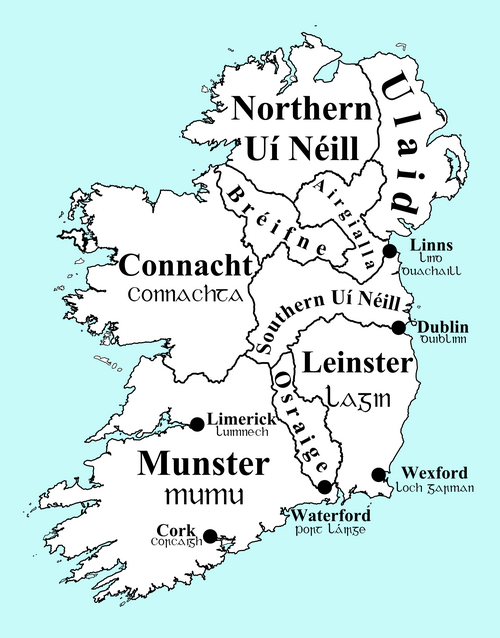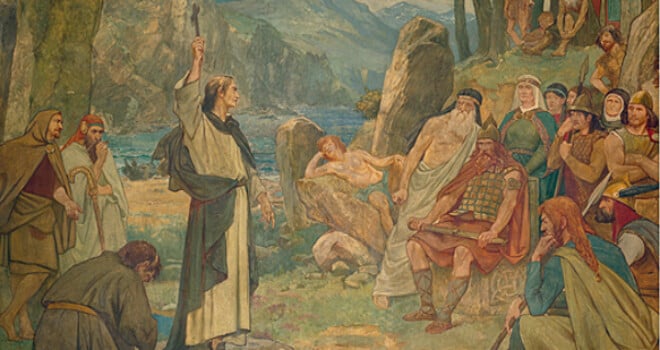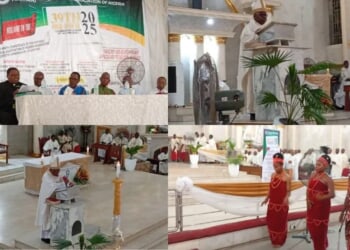From the beginning of Christian history, Christian monarchs have been important characters in the establishment of Christendom. Figures like St. Stephen of Hungary, King Clovis of France, and St. Ethelbert of England figure prominently in the histories of the early Middle Ages and are renowned among their respective peoples. And who has not heard of the great Constantine, first Christian emperor of Rome?
But what of Christian Ireland? Who was the first king of the Irish to proclaim the Faith of Jesus Christ?
Though there was no single royal conversion that brought about the Christianization of Ireland, there were certainly Christian monarchs of note. The most important Christian monarch was undoubtedly Diarmait mac Cerbaill, the first Christian High King of Ireland.
Diarmait did not have a long reign; he probably only ruled from 558 to 565. Still, his reign was of tremendous importance for both the political and religious situation in Ireland. But before we discuss Diarmait, we must understand the nature of ancient Ireland’s kingship.
Ireland in the 6th century had no single monarch. It was a patchwork of kingdoms ruled by petty chiefs and provincial rulers, all of whom might be styled “kings.” These kings were all more or less independent, supreme within their lands. For this reason, it is not even right to speak of a “kingdom” of Ireland at this time; it is better understood as a complex patchwork of loyalties tied together in a knot of marriages, conquests, and oaths of fealty.
The only national unity in such a system was found in the institution of the High Kings of Tara. Tara is a hill in Meath which was considered sacred since ancient times. Because of its mystical significance, Gaelic kings inaugurated at Tara were venerated with a special aura.
They were called Ard rí, “High Kings.” The Ard rí were more than just territorial rulers; they were considered symbols of the Irish people. At the time of Diarmait mac Cerbaill, the powers of the High King seem to have been largely symbolic, a rulership of prestige. Still, this prestige was not inconsiderable, and Diarmait’s reign was instrumental in establishing Christianity on the island.


According to the ancient annals, Diarmait mac Cerbaill was the son of Fergus Cerrbél, the grandson of the semi-legendary ruler Niall of the Nine Hostages, the founder of the powerful Uí Neill clan. By the time of Diarmait, the Uí Neill had become the most powerful clan in north Ireland. Diarmait was born in Meath of a predominantly Christian branch of the Uí Neill. At the time, the High King of Tara was Tuathal Máelgarb, a member of a rival Uí Neill branch. King Tuathal feared Diarmait and exiled him. The young prince went into County Offaly, in Leinster, to live out his exile.
There he encountered a monk named St. Ciaran. Ciaran and Diarmait were both young men and soon became friends. Diarmait learned that his new friend had come to Offaly to found a church, so he offered to help Ciaran with the endeavor. Ciaran happily agreed, and the two young men, prince and ascetic, worked all day clearing land, cutting wood, and driving posts.
At the end of the day, with the chapel constructed and the two men resting, St. Ciaran thanked Diarmait for his help and prayed for the young prince, telling him, “Thou shalt be a king tomorrow.” The church the men built would become known as Clonmacnoise. It would become one of the most important monastic centers in Ireland.
And Ciaran’s prophecy came to pass. That very day, King Tuathal was murdered by a kinsman of Diarmait. The assassin was then immediately slain by Tuathal’s guards. With the High King dead, Diarmait was recalled from exile to take up the kingship of the Southern Uí Neill.
Diarmait ruled as King of the Uí Neill for over ten years, strengthening his kingdom by war, diplomacy, and dynastic marriages. He also remembered his friend St. Ciaran and supported the monastery of Clonmacnoise. Soon Diarmait was recognized as the most important king in Ireland and claimed the title of Ard rí sometime around 558.
Though a Christian, the king went through the traditional pagan ban-feis ceremony of marriage to the land at Tara—although Diarmait would be the last to do so. Even so, Diarmait used his influence as High King to promote the Christian Faith throughout Ireland. He encouraged the construction of monasteries, supported Christian missions, donated land to holy monks for the erection of churches, and in general lent the moral prestige of the High Kingship to the new faith.
Diarmait’s reign as High King was fraught with difficulties, however, many brought about by his own poor judgment. Though a Christian, he did not respect the sanctuary of churches. When a rival fled to the Abbey of Lorrha and sought the protection of St. Ruadán, Diarmait entered the abbey and slew the man. St. Ruadán was furious at this violation of sacred space. He cursed Diarmait and prophesied that the king would die by having a roofbeam fall on his head.
Not long after, When one of Diarmait’s relatives was killed, Diarmait pursued the murderer, who had taken shelter in the abbey of another holy man, St. Columba. Diarmait boldly entered Columba’s monastery, dragged the man out, and killed him.
St. Columba would be the cause of Diarmait’s downfall.
Columba was born a prince of a rival branch of the Uí Neill. He entered the service of the Church and became a disciple of St. Finian of Movilla, a renowned abbot and scholar. St. Columba had made a copy of the Psalter of Movilla without St. Finian’s permission. Finian requested that Columba return his copied manuscript, but Columba refused. The two saints decided to ask King Diarmait to arbitrate the dispute. Diarmait was hostile to St. Columba and ruled against him, ordering Columba to hand over his manuscript to Finian.
Columba did not give up, however. He went north and raised such a din amongst his kinsman that the Northern Uí Neill started arming for war. King Diarmait likewise armed his kinsmen of the Southern Uí Neill. The two clans met in combat and fought what has been called the “Battle of the Book.”
King Diarmait was defeated by the Northern Uí Neill. This loss caused other Irish lords to rise up and contest the power of the Ard rí. Diarmait was defeated in another battle against the King of Leinster. After this, when the Southern Uí Neill went to war, they didn’t even bother to bring Diarmait along. He was ostracized by his allies. Perhaps they believed he was bad luck.
By the end of his life, Diarmait had grown bitter and autocratic. Recall that St. Ruadán had prophesied that Diarmait would die by having a roofbeam fall upon his head. Alarmed by this, Diarmait consulted his old friend, St. Ciaran. St. Ciaran, too, told the king he would be killed by a roofbeam striking his head. King Diarmait decided to ask his Druid, Bec mac Dé, who had a reputation for prophecy. Bec told the king he would die by being burned, drowned, and have his head crushed by a roofbeam. He also told the king his killer would be Áed Dub, a chief who had once been Diarmait’s ally. Furthermore, Bec said his death would occur in the hall of one Banbán, and the signs of his death would be a shirt grown from a single seed of flax, ale brewed from one seed of corn, and bacon from a sow which has never farrowed.
Diarmait scoffed at these strange details. To show how little he regarded the prophecy, he went to dine at the hall of Banbán, where Bec predicted his demise. After feasting, his host, Banbán, gave Diarmait a nightshirt to wear. Diarmait marveled at the craftsmanship of the shirt. Banbán’s daughter told the king, “That shirt has been woven from flax grown from a single seed.” Then she told him that the pork he had eaten had come from a sow that had never farrowed and the beer had been brewed from a single seed of corn. Diarmait was overcome with fright; he immediately tried to flee the hall but found his rival Áed Dub standing outside the door. Áed Dub had entered into a conspiracy with Banbán to lure Diarmait to the hall so that he might kill him.
Diarmait retreated back into the hall, but his enemies set it on fire. In order to escape the flames, Diarmaid dove into a large vat of ale. As the hall collapsed around him, a flaming roofbeam fell on his head, killing him instantly. Thus the prophecies all came to pass.
The death of King Diarmait mac Cerbaill probably occurred in 565. The manner of his death was known as the “Triple Death” amongst the Gaels; such deaths were considered punishments for very specific sins. This illustrates the mixed legacy of Diarmait. Like King Saul of Israel, he seems to have been a kind and pious man in his youth, but the rigors of life and the burdens of the kingship hardened him. By the time he died, he had grown tyrannical and was unloved.
Christian authors weren’t sure what to make of Diarmait. Writing in the 7th century, St. Adomnán presented Diarmait as a pious man whose reign was ordained by God; other annals depicted him in constant conflict with the clergy. Probably both views are true, depending on whether we are talking about young Diarmait or old Diarmait.
One thing is certain: the death of Diarmait signified the passing of an age. Though Diarmait’s latter years were tragic, in his prime he was an ardent defender of the Faith and worked zealously to establish Catholicism throughout his dominions.
The life of King Diarmait mac Cerbaill reminds us that Catholic history does not always progress in a straight line. People are, after all, quite complicated creatures. While we rightly celebrate the accomplishments of the saints and decry the deeds of the wicked, the vast majority of people are somewhere in between these two poles, their lives an intricate knot of virtue and vice, triumphs and setbacks, strengths and weaknesses. Diarmait was no saint, but he played a pivotal role in the establishment of the Faith in Ireland, for which he deserves to be remembered, for all of us alike have our parts to play in God’s grand tapestry.
Image from National Galleries Scotland


















